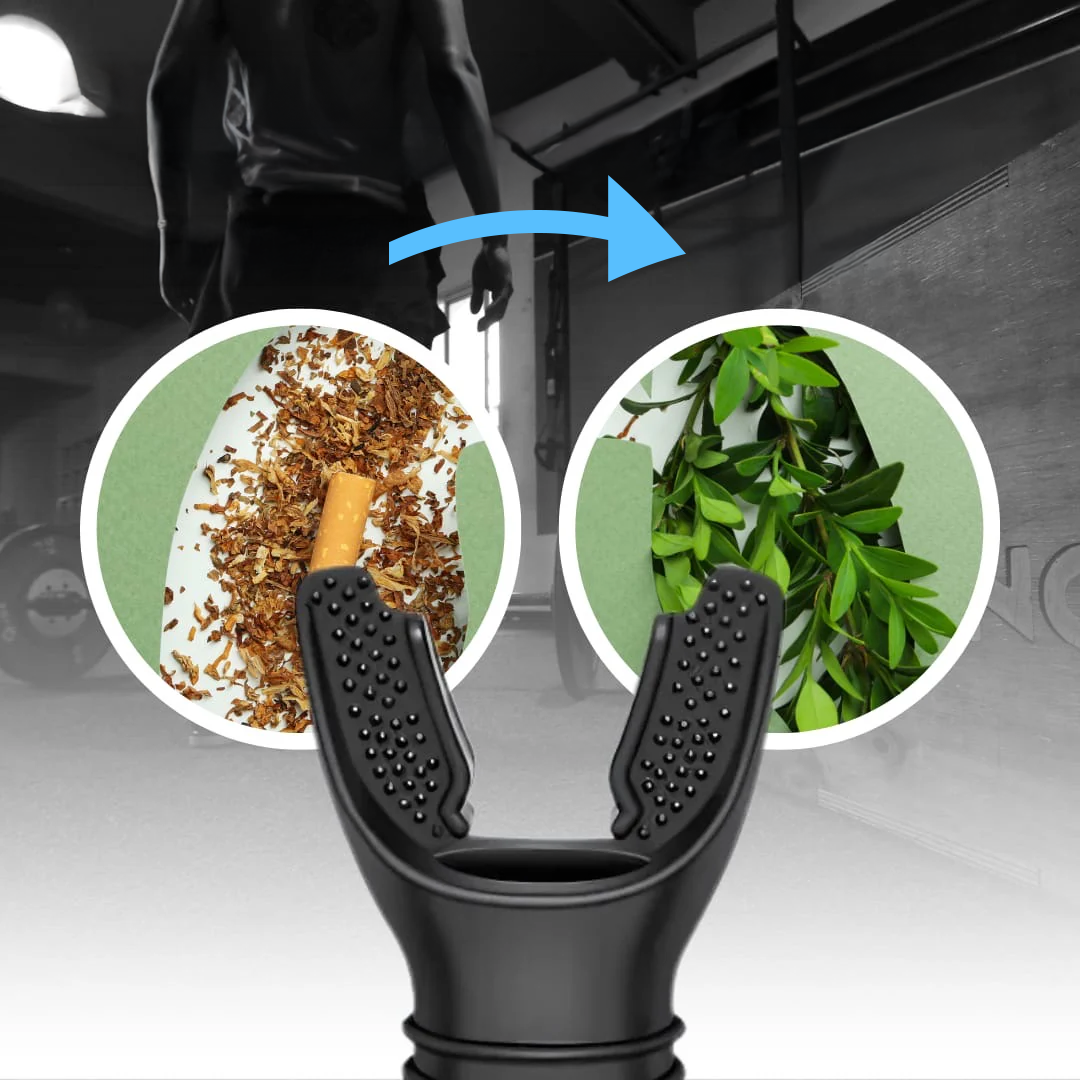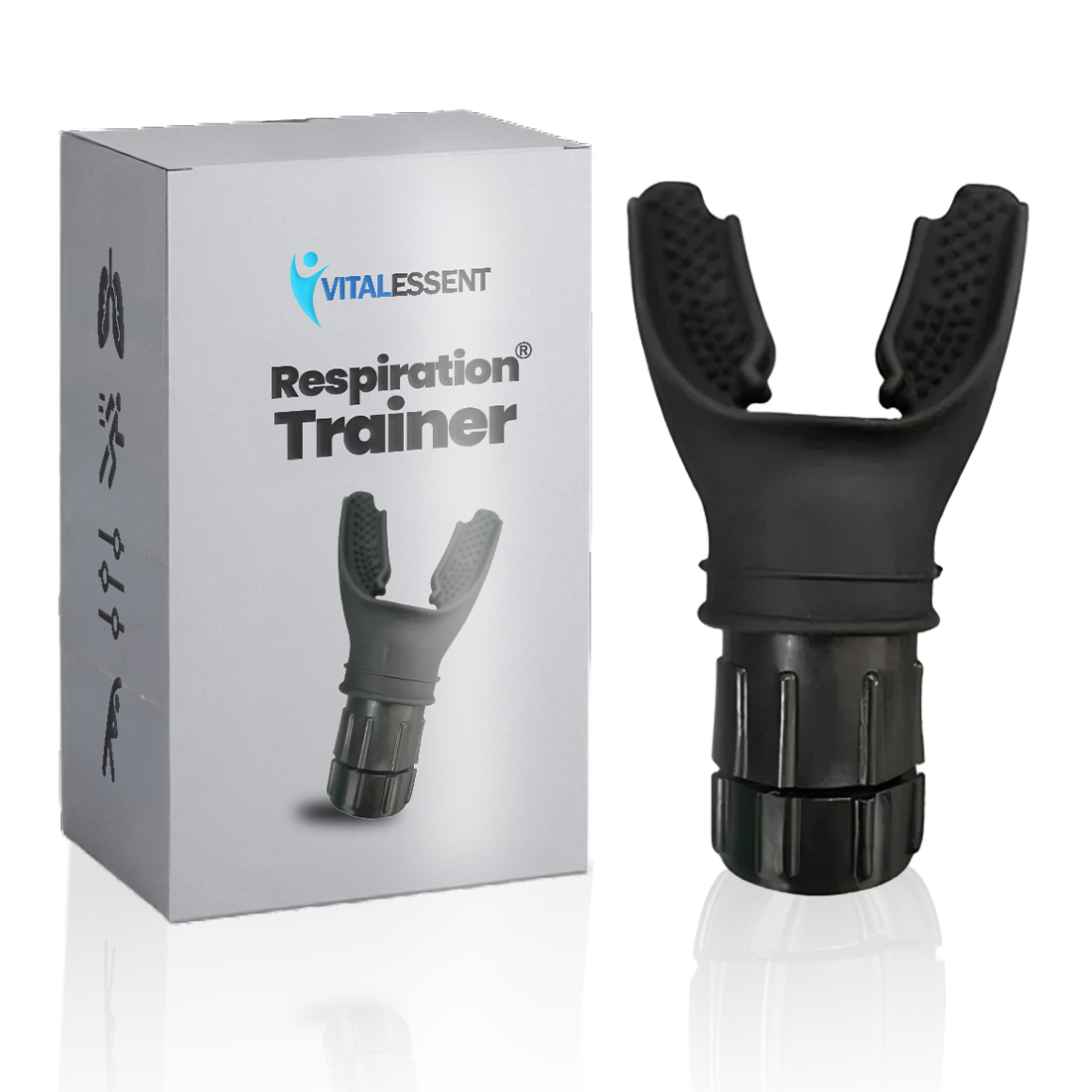7 Reasons why your lungs are begging for this.
Want to relieve breathing problems? Or want to improve stamina and boost performance. Well this might be the solution you were waiting for. Claims in this article scientificically backed. (report below)

"Finally, something that works for my husband! Best of all he sleeps as a charm." - Amanda (46)

1. Breathe Better and Easier Every Day
Study found that breathing exercises significantly boosted lung capacity, making it easier to take in and use air effectively. This means you can breathe more comfortably during daily activities like walking, climbing stairs, or even just talking, especially if smoking or aging has made breathing harder. It can help you feel less winded and more energetic in your routine..
[ Source: Breathing exercises on lung capacity, 2024 ]

2. Get Stronger for Fun Activities
The research showed that these exercises strengthened the muscles involved in breathing, improving their coordination and stamina. This translates to better support for your breathing during physical efforts, reducing shortness of breath and making activities like exercise, gardening, or playing with grandchildren more enjoyable and less tiring.
[ Source: Breathing exercises on lung capacity, 2024 ]

3. Significant Reduction in Stress and Anxiety
The study showed that breathing exercises effectively lowered feelings of stress and anxiety for many people, from healthy individuals to those facing medical challenges or stressful situations. This means you can feel calmer and more at ease during daily pressures like work deadlines, family responsibilities, or personal worries, improving your overall mood and peace of mind.
[ Source: Breathing exercises on lung capacity, 2024 ]

4. Relax Your Body and Sleep Better Tonight
These exercises help your body switch from a "fight or flight" mode to a more relaxed state by balancing your nervous system. This can lead to less physical tension, better sleep, and a greater sense of calm, making it easier to handle stressful moments like public speaking or crowded places without feeling overwhelmed.
[ Source: Breathing for stress and anxiety, 2023 ]

5. Take Charge of Stress. Any time Anywhere.
Vitalessent respiration trainer is easy to learn, no need of expensive equipement, and work anywhere—like home, school, or a break. This means you can take control of your stress anytime, without financial burden, fitting it into your busy schedule to feel better on your terms.
[ Source: Breathing for stress and anxiety, 2023 ]

6. Build a Tougher, Happier Mind
Regular practice over time, with multiple sessions of 5+ minutes, was shown to build lasting strength against stress and anxiety. This can help you become more resilient to life’s ups and downs, like managing chronic worries or bouncing back from tough days, leading to a steadier, more confident mindset over the long haul.
[ Source: Breathing for stress and anxiety, 2023 ]
7. In a world full of copy cats, Vitalessent respiration trainer is a unicorn
We pride ourselves in our quality and focus on sleep, we cannot say the same for others.
Fall asleep quicker
Relax & Restorative sleep
Wake up refreshed
Anti-snoring


Increase lung capacity
Strengten breathing muscles
Reduces fatique
Inconvenient
Easy & simple
Increase endurance
Backed by science
References
[1] Kessler, R.C.; Berglund, P.; Demler, O.; Jin, R.; Merikangas, K.R.; Walters, E.E. Lifetime Prevalence and Age-of-Onset Distributions of DSM-IV Disorders in the National Comorbidity Survey Replication. Arch. Gen. Psychiatry 2005, 62, 593–602. [CrossRef]
[2] Santomauro, D.F.; Herrera, A.M.M.; Shadid, J.; Zheng, P.; Ashbaugh, C.; Pigott, D.M.; Abbafati, C.; Adolph, C.; Amlag, J.O.; Aravkin, A.Y.; et al. Global Prevalence and Burden of Depressive and Anxiety Disorders in 204 Countries and Territories in 2020 Due to the COVID-19 Pandemic. Lancet 2021, 398, 1700–1712. [CrossRef]
[3] DuPont, R.L.; Rice, D.P.; Miller, L.S.; Shiraki, S.S.; Rowland, C.R.; Harwood, H.J. Economic Costs of Anxiety Disorders. Anxiety 1996, 2, 167–172. [CrossRef]
[4] Kalia, M. Assessing the Economic Impact of Stress—The Modern Day Hidden Epidemic. Metabolism 2002, 51, 49–53. [CrossRef]
[5] Niles, A.N.; O’Donovan, A. Comparing Anxiety and Depression to Obesity and Smoking as Predictors of Major Medical Illnesses and Somatic Symptoms. Health Psychol. Off. J. Div. Health Psychol. Am. Psychol. Assoc. 2019, 38, 172–181. [CrossRef]
[6] Kang, H.-J.; Bae, K.-Y.; Kim, S.-W.; Shin, H.-Y.; Shin, I.-S.; Yoon, J.-S.; Kim, J.-M. Impact of Anxiety and Depression on Physical Health Condition and Disability in an Elderly Korean Population. Psychiatry Investig. 2017, 14, 240–248. [CrossRef]
[7] Jonas, B.S.; Franks, P.; Ingram, D.D. Are Symptoms of Anxiety and Depression Risk Factors for Hypertension? Longitudinal Evidence from the National Health and Nutrition Examination Survey I Epidemiologic Follow-up Study. Arch. Fam. Med. 1997, 6, 43–49. [CrossRef]
[8] Eaker, E.D.; Sullivan, L.M.; Kelly-Hayes, M.; D’Agostino, R.B.; Benjamin, E.J. Tension and Anxiety and the Prediction of the 10-Year Incidence of Coronary Heart Disease, Atrial Fibrillation, and Total Mortality: The Framingham Offspring Study. Psychosom. Med. 2005, 67, 692–696. [CrossRef]
[9] Reiche, E.M.V.; Nunes, S.O.V.; Morimoto, H.K. Stress, Depression, the Immune System, and Cancer. Lancet Oncol. 2004, 5, 617–625. [CrossRef]
[10] Rozanski, A.; Blumenthal, J.A.; Kaplan, J. Impact of Psychological Factors on the Pathogenesis of Cardiovascular Disease and Implications for Therapy. Circulation 1999, 99, 2192–2217. [CrossRef]
[11] Schneiderman, N.; Ironson, G.; Siegel, S.D. STRESS AND HEALTH: Psychological, Behavioral, and Biological Determinants. Annu. Rev. Clin. Psychol. 2005, 1, 607–628. [CrossRef]
[12] Yaribeygi, H.; Panahi, Y.; Sahraei, H.; Johnston, T.P.; Sahebkar, A. The Impact of Stress on Body Function: A Review. EXCLI J. 2017, 16, 1057–1072. [CrossRef]
[13] Machado, A.; Herrera, A.J.; de Pablos, R.M.; Espinosa-Oliva, A.M.; Sarmiento, M.; Ayala, A.; Venero, J.L.; Santiago, M.; Villarán, R.F.; Delgado-Cortés, M.J.; et al. Chronic Stress as a Risk Factor for Alzheimer’s Disease. Rev. Neurosci. 2014, 25, 785–804. [CrossRef]
[14] Vyas, S.; Rodrigues, A.J.; Silva, J.M.; Tronche, F.; Almeida, O.F.X.; Sousa, N.; Sotiropoulos, I. Chronic Stress and Glucocorticoids: From Neuronal Plasticity to Neurodegeneration. Neural Plast. 2016, 2016, 6391686. [CrossRef]
[15] McEwen, B.S. Central Effects of Stress Hormones in Health and Disease: Understanding the Protective and Damaging Effects of Stress and Stress Mediators. Eur. J. Pharmacol. 2008, 583, 174–185. [CrossRef]
[16] Carpenter, J.K.; Andrews, L.A.; Witcraft, S.M.; Powers, M.B.; Smits, J.A.J.; Hofmann, S.G. Cognitive Behavioral Therapy for Anxiety and Related Disorders: A Meta-Analysis of Randomized Placebo-Controlled Trials. Depress. Anxiety 2018, 35, 502–514. [CrossRef]
[17] Bandelow, B.; Michaelis, S.; Wedekind, D. Treatment of Anxiety Disorders. Dialogues Clin. Neurosci. 2017, 19, 93–107. [CrossRef]
[18] Sengupta, P. Health Impacts of Yoga and Pranayama: A State-of-the-Art Review. Int. J. Prev. Med. 2012, 3, 444–458.
[19] Cramer, H.; Lauche, R.; Anheyer, D.; Pilkington, K.; de Manincor, M.; Dobos, G.; Ward, L. Yoga for Anxiety: A Systematic Review and Meta-Analysis of Randomized Controlled Trials. Depress. Anxiety 2018, 35, 830–843. [CrossRef]
[20] Sellakumar, G. Effect of Slow-Deep Breathing Exercise to Reduce Anxiety among Adolescent School Students in a Selected Higher Secondary School in Coimbatore, India. J. Psychol. Educ. Res. (JPER) 2015, 23, 54–72.
[21] Kim SK: Effect of Aerobic Exercise on the Improvement in Middle Aged Women. Master’s thesis, Graduate School of Korea National Sport University, 2008, pp 1–3.
[22] Nelson ME, Rejeski WJ, Blair SN, et al. American College of Sports Medicine American Heart Association: Physical activity and public health in older adults: recommendation from the American College of Sports Medicine and the American Heart Association. Circulation, 2007, 116: 1094–1105. [Medline] [CrossRef]
[23] Mori RL, Bergsman AE, Holmes MJ, et al.: Role of the medial medullary reticular formation in relaying vestibular signals to the diaphragm and abdominal muscles. Brain Res, 2001, 902: 82–91. [Medline] [CrossRef]
[24] Chien MY, Kuo HK, Wu YT: Sarcopenia, cardiopulmonary fitness, and physical disability in community-dwelling elderly people. Phys Ther, 2010, 90: 1277–1287. [Medline] [CrossRef]
[25] Jung HJ, Lee DT: Inspiratory muscle training, aerobic exercise, pulmonary function, maximal oxygen uptake, inspiratory pressure. Exerc Sci, 2012, 21: 373–384. [CrossRef]
[26] Roh H, Lee D, Lee S, et al.: Respiratory muscle training of pulmonary function for smokers and non-smokers. J Phys Ther Sci, 2012, 24: 691–693. [CrossRef]
[27] Byun YH, Kim SH, Kim TS: Effect of body mass index difference on body composition, cardiopulmonary, low extremity muscular functions in institutionalized older women. J Sport Leis Stud, 2013, 52: 789–799.
[28] Cha KS: A comparison of pulmonary function, aerobic power, blood pressure, blood hemoglobin in smokers and non-smokers. Korean J Phys Educ, 2001, 40: 845–857.
[29] Mokdad AH, Marks JS, Stroup DF, et al.: Actual causes of death in the United States, 2000. JAMA, 2004, 291: 1238–1245. [Medline] [CrossRef]
[30] Shaw M, Mitchell R, Dorling D: Time for a smoke? One cigarette reduces your life by 11 minutes. BMJ, 2000, 320: 53–53. [Medline] [CrossRef]
[31] Kim J, Lim SA: The realities of smoking among some college students and their relevant knowledge. J Korean Soc Dent Hyg, 2006, 6: 283–294.
[32] Tantisuwat A, Thaveeratitham P: Effects of smoking on chest expansion, lung function, and respiratory muscle strength of youths. J Phys Ther Sci, 2014, 26: 167–170. [Medline] [CrossRef]
[33] Lee SK, Park JW, Kim KH, et al.: An analysis of the thickness of abdominal muscles during forceful expiration and pulmonary function in teenage smokers and nonsmokers. J Phys Ther Sci, 2013, 25: 789–791. [Medline] [CrossRef]
[34] Kim JS: Effects of a balloon-blowing exercise on lung function of young adult smokers. J Phys Ther Sci, 2012, 24: 531–534. [CrossRef]
[35] Weiner P, Magadle R, Beckerman M, et al.: Comparison of specific expiratory, inspiratory, and combined muscle training programs in COPD. Chest, 2003, 124: 1357–1364. [Medline] [CrossRef]
[36] Kido S, Nakajima Y, Miyasaka T, et al.: Effects of combined training with breathing resistance and sustained physical exertion to improve endurance capacity and respiratory muscle function in healthy young adults. J Phys Ther Sci, 2013, 25: 605–610. [Medline] [CrossRef]
[37] Carr M, Jones J: Physiological effects of exercise on stroke survivors. Top Stroke Rehabil, 2003, 9: 57–64. [Medline] [CrossRef]
[38] Kim DS: The relationship of age, weight, height and smoking history with spirometric parameters in healthy adults. Bulleum Dongnam Health Coll, 2003, 21: 429–440.
[39] Kim YS: The effect of the combined exercise on the risk factors for health related physical fitness, blood lipids, and cardiovascular diseases in the elderly women. Doctoral thesis, Graduate School of Kangnung National University, 2007, pp 9–11.
[40] Na HR: Explorative study on fatigue in patients with chronic obstructive pulmonary disease. Master’s thesis, Graduate School of Kyung Hee University, 2000, pp 7–9.

 Payable after receipt.
Payable after receipt.